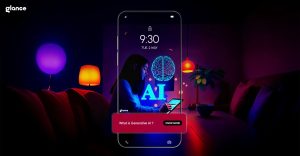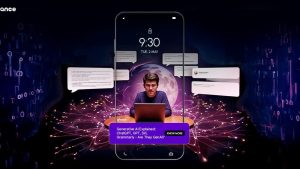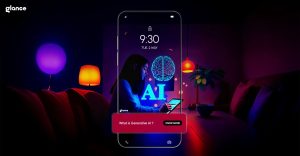
Picture this: you’re unlocking your phone for the 60th time today, not looking for anything in particular. Then, without opening an app or typing a word, you see it—a look that feels made for you. The colors match your mood, the fit flatters your frame, and the style aligns perfectly with your weekend vibe.
You weren’t shopping. But you just started.
Welcome to the world of AI personalized shopping journeys, where Glance AI is leading a quiet revolution—turning idle moments into emotionally intelligent commerce touchpoints. This isn’t ecommerce as usual. It’s curated discovery layered into the rhythms of mobile life.
In this blog, we unpack how Glance’s lock screen-powered, visual-first, and behavior-responsive ecosystem transforms every scroll, swipe, and pause into a personalized shopping experience—and why this model is setting the tone for the future of mobile AI shopping.
For the full strategy, don’t miss the AI Shopping Guide, which details how Glance is building AI-native, zero-click commerce from the ground up.
Why Mobile Shopping Needed a Rethink
Let’s be honest—shopping on mobile can be exhausting.
You open an app. Wait for it to load. Type in something vague like “nice summer top.” Scroll past 57 items that don’t look or feel right. Apply a few filters. Still too many results. You give up.
And you’re not alone. Studies show that over 80% of users abandon mobile shopping journeys mid-scroll due to friction, decision fatigue, or irrelevant results (Baymard Institute).
This is exactly what AI-powered personalization fixes.
By learning from micro-interactions (scroll speed, tap patterns, dwell time), AI doesn’t just recommend products—it recognizes patterns of interest. It anticipates what you might want next and presents it before you even go looking.
With Glance, that presentation happens the moment you unlock your phone.
The mobile screen isn’t just an entry point anymore. It’s the experience itself.
The Power of the Lock Screen: Discovery Without Effort
Glance AI does something radically different: it turns your phone’s lock screen into a personalized style feed.
Think of it as your daily fashion magazine—AI-curated, refreshingly visual, and context-aware.
Here’s what makes it revolutionary:
- No app open required
- No login friction
- No overwhelming grids of products
Each time you unlock your phone, you’re met with 3–5 styled looks. These aren’t static product images—they’re full-blown editorial layouts styled around your:
- Body type
- Aesthetic persona (festive, bold, minimalist, etc.)
- Engagement history (what you liked, saved, or paused on)
And the data supports the design. According to Glance’s internal reports, user actions like “Add to Lock Screen,” “Buy Now,” and downloads have steadily increased, showing strong behavioral alignment with visual-first content.
It’s not just about saving time. It’s about aligning with attention—those first few seconds where curiosity beats intent.
AI Personas: Why the Algorithm Feels More Like a Stylist
Personalization isn’t new. But Glance gives it a face—yours.
Onboarding begins with a selfie, followed by quick selections for:
- Body type
- Hair type
- Skin tone
- Style preferences (casual, bold, ethnic, etc.)
This builds your AI persona, which Glance’s algorithm uses as a foundation to:
- Style complete outfits
- Recommend color palettes and silhouettes
- Tailor looks to your real-life proportions—not just trends
And it’s not static. Your persona evolves based on how you interact. Download more ethnic looks during the festive season? Expect more fusion wear. Scroll past bold prints? You’ll start seeing cleaner aesthetics.
It’s not guesswork. It’s machine learning modeled after human taste.
This kind of adaptive personalization has a massive impact. Shopify reports that retailers using AI personalization see up to 150% higher conversions and 40% larger cart sizes (Shopify Plus).
Visual UX That Converts—Without Feeling Like Shopping
Gen Z and millennial shoppers don’t want to “go shopping.” They want to feel inspired.
That’s why Glance replaces the traditional ecommerce grid with scrollable, full-screen lookbooks. Each layout feels like a social carousel—beautifully styled, effortless to consume, and always tappable.
What you’ll see:
- A model styled according to your persona
- Tappable product tiles (e.g., shirt, jeans, earrings)
- CTA buttons like “Shop This Look,” “Try This On,” or “Save to Lock Screen”
There’s no filter maze. No dropdown menus. Just fluid motion from inspiration to interaction.
It feels more like flipping through Instagram stories than using a shopping app. And that’s the point.
Glance mirrors how digital-native users consume content—aesthetic-first, low-effort, highly shareable.
Scroll Behavior = Intent Signal: How Glance AI Learns
Here’s where the AI earns its magic.
Every user gesture—however subtle—is a signal.
- Pause for more than 2 seconds on a look? That’s interest.
- Tap a product tile? That’s preference.
- Scroll quickly past? That’s disinterest.
Glance AI logs these signals in real time and reweights your persona accordingly.
This behavioral loop means:
- Your lookfeed improves with every use
- The AI gets smarter even if you don’t tap or buy
- Looks get more relevant without becoming repetitive
And this isn’t just user-friendly. It’s commercially powerful.
McKinsey estimates that personalization at scale can lift revenues by 10–30% and reduce acquisition costs by up to 50% (McKinsey & Company).
Glance makes that scalable—across tens of millions of devices, without requiring login credentials or app installations.
From Discovery to Checkout in One Tap
One of the biggest friction points in mobile commerce? Checkout.
Too many clicks. Too much hesitation. Not enough confidence.
Glance solves this with:
- One-tap “Buy Now” buttons integrated into lookbooks
- Shop the Look flows that bundle items into ready-to-buy edits
- Upcoming AI virtual try-on shopping to reduce fit anxiety and improve purchase confidence
These design elements don’t just shorten the funnel. They eliminate it.
Because the journey doesn’t feel like a funnel anymore—it feels like scroll, feel good, tap, done.
For mobile users with shrinking attention spans, this UX is crucial. According to Google, 53% of mobile users abandon sites that take longer than 3 seconds to load, and conversion drops 12% for every second of delay (Think With Google).
Glance reduces decision time—not by rushing you, but by removing cognitive load.
Case Study: The Lock Screen to Cart Experience
Let’s say Ayesha, a 23-year-old student in Pune, unlocks her phone during a lecture break. Glance shows her a festive Indo-Western look styled for her exact body type and aesthetic profile.
- She pauses on the look for 4 seconds.
- Taps the jhumka tile.
- Hits “Shop Similar” for a more affordable version.
- Saves the look to her lock screen.
- Buys it later that evening, all from the same screen.
This is scroll-to-shop at its most seamless.
Ayesha didn’t search. She didn’t browse. She discovered, engaged, and converted—without leaving her natural mobile flow.
Multiply this by millions of users, and you have a commerce engine not driven by ads, but by emotional relevance.
How This Expands Glance’s AI Shopping Ecosystem
Glance’s lock screen personalization is just one surface in its expanding AI commerce ecosystem.
According to the AI Shopping Guide, Glance is also investing in:
- AI look generation for connected TVs
- Voice-led fashion prompts
- Try-on overlays using AR and body mapping
- Cross-device style syncing between mobile and TV
All of this ties back to one central principle: contextual commerce delivered in the moment of intent—or before it.
That’s what makes Glance an AI-native shopping platform—not just a feature layer on top of ecommerce.
Conclusion: Scrolls Are the New Searches
Shopping doesn’t begin with intent anymore.
It begins with a scroll, a swipe, or a pause. It begins when something just feels right—before we’ve even realized we were looking for it.
That’s the superpower of AI personalized shopping journeys. And Glance is building the blueprint.
By embedding smart discovery into mobile behaviors—without interrupting them—Glance transforms every device into a visual stylist, moodboard, and shoppable canvas.
Want to see how this personalization strategy scales across connected TVs, virtual try-ons, and voice-led commerce?
Read the full AI Shopping Guide for more trends, features, and strategic insights.
Because in the era of AI commerce, the best stores?
Aren’t on websites. They’re in your scroll.





